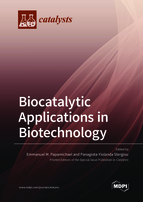Biocatalytic Applications in Biotechnology
A special issue of Catalysts (ISSN 2073-4344). This special issue belongs to the section "Biocatalysis".
Deadline for manuscript submissions: closed (15 August 2020) | Viewed by 50245
Special Issue Editors
Interests: chemical and enzyme kinetics (homogeneous/heterogeneous reactions); enzymology; enzyme biotechnology; biofuel production; statistical analysis of experimental data; experimental design; computer programming
Special Issues, Collections and Topics in MDPI journals
Interests: biocatalysis; enzyme biotechnology (food biotechnology and biofuel production); experimental design
Special Issues, Collections and Topics in MDPI journals
Special Issue Information
Dear Colleagues,
Nowadays, the vast increasing demand of novel biotechnological products is supported through the continuous development of biocatalytic applications. As a consequence, the progress of research regarding the enzymatic catalysis in aqueous, non-aqueous, organic (polar or non-polar), and/or non-solvent media is decisive. Experimental design methods, which also may comprise of in silico studies; the design of specific reactors and conditions; reactions of significant chemical and/or biochemical processes, which are relevant to industrial production; enzyme kinetic methods; the investigation of enzymatic mechanisms; and the use of immobilized enzymes and/or microbial cells on various inert matrices are importantly useful. A plethora of enzymes of several classes, which may potentially be used as biocatalysts in biotechnological applications, are available today. Among these enzymes, the more common are oxidoreductases (e.g., laccase, catalase, glucose oxidase, etc.), hydrolases (e.g., amylases, lipases, proteases, amidases, cellulases, esterases, etc.), isopmerases (e.g., epimerases, topoisomerases, mutases, etc.), and others. By means of the aforementioned biocatalysts and the utilization of specific biotechnological methods, important, cost-effective, sustainable, and environmentally friendly processes have been applied for the synthesis and/or the conversion of a huge amount of market-required products.
Prof. Dr. Emmanuel M. Papamichael
Dr. Panagiota-Yiolanda Stergiou
Guest Editors
Manuscript Submission Information
Manuscripts should be submitted online at www.mdpi.com by registering and logging in to this website. Once you are registered, click here to go to the submission form. Manuscripts can be submitted until the deadline. All submissions that pass pre-check are peer-reviewed. Accepted papers will be published continuously in the journal (as soon as accepted) and will be listed together on the special issue website. Research articles, review articles as well as short communications are invited. For planned papers, a title and short abstract (about 100 words) can be sent to the Editorial Office for announcement on this website.
Submitted manuscripts should not have been published previously, nor be under consideration for publication elsewhere (except conference proceedings papers). All manuscripts are thoroughly refereed through a single-blind peer-review process. A guide for authors and other relevant information for submission of manuscripts is available on the Instructions for Authors page. Catalysts is an international peer-reviewed open access monthly journal published by MDPI.
Please visit the Instructions for Authors page before submitting a manuscript. The Article Processing Charge (APC) for publication in this open access journal is 2700 CHF (Swiss Francs). Submitted papers should be well formatted and use good English. Authors may use MDPI's English editing service prior to publication or during author revisions.
Keywords
- Enzymatic catalysis
- Biocatalysis
- Biotechnological applications
- In silico simulations
- Experimental design
- Reactor design
- Process optimization
- Immobilized enzymes
- Whole cell biocatalysis







